| |
|
 | |
| MaltaWildPlants.com by Stephen Mifsud |

|
| |
|
|
 |  |  |  |
| External Links: |
|
Ecballium elaterium (Squirting Cucumber) |
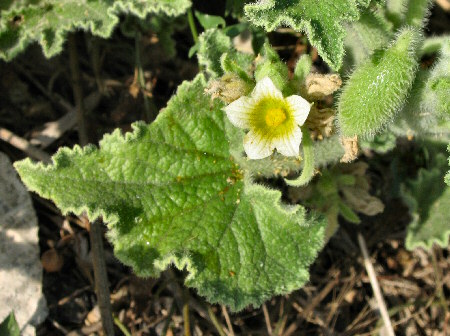
Ecballium elaterium (CUCURBITACEAE.)
Images for this profile are taken from the Maltese Islands after year 2000. |
|
| Nomenclature |
Species name : | Ecballium elaterium (L.) A.Rich. | Authority : | Carl von Linne, Sweden, (1707 - 1778) ;
Achille Richard, France, (1794 - 1852) | Synonyms :
(basionym or principal syn.) |
|
Plant Family : | Cucurbitaceae Juss.
(Gourd or Cucumber Family) | English name(s) : | Squirting Cucumber, Spitting Cucumber, Wild Balsam-Apple | Maltese name(s) : | Faqqus il-ħmir, Bettieħ il-ħmir | Status for Malta : | Indigenous. Present on the Maltese islands before man | Name Derivation : |
Ecballium: From ekballein meaning to cast out forcefully, referring to the forceful ejection of the seeds when the fruit is ripe ! (Greek origin ); 2 = From ekballein (to cast out), referring to the forceful ejection of the seeds when the fruit is ripe (Greek).
elaterium: from elatos meaning to drive or expel away violently, again for the powerful expulsion of seeds of this plant when the fruit are touched or ripe. (Greek origin ); 2 = from elatos (to drive, strike), referring either to the forceful expulsion of seeds from this plant or to the fact that the extract is a violent purgative (Greek).
| Remarks : | |
|
| Morphology and structure |
PLANT STRUCTURE: |
Character | Growth Form | Branching | Surface |
Description | | | |
General
Picture | 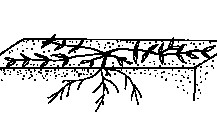 |  | 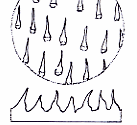 |
|
LEAVES: |
Character | Arrangement | Attachment | Venation |
Description | | | |
General
Picture |  | 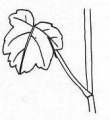 |  |
| |
Character | Leaf Shape | Leaf Margin | Remarks |
Description | | | Indented leaf Base Basal edge of leaf is indented. |
General
Picture |  | 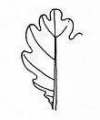 |  |
|
FLOWERS: |
Character | Colour | Basic Flower Type | No. of Petals | No. of Sepals |
Description | Yellow to cream Yellow center with pale yellow or cream border at the periphery. | | 5 (partially fused). | 5 (free). |
General
Picture | |  |  |  |
| |
Character | Inflorescence | Description | Ovary | Stamens |
Description | Female: Solitary
Male: Auxiliary clusters Male flowers are arranged in a cluster of 4-6 flowers of different stalk lengths and maturity. They arising from a common flowering stem. Female and male flowering stems both arise from the same point at leaf axil. | Male and female flowers are of same size, both trumpet shaped, and yellow to cream (female slight tinge in green). Male flowers have 3 stamens with closely packed coiled yolk-yellow anthers and female flower has 3 large, green stigma each divided into 2 swollen parts or lobes. | | |
General
Picture |  |  |  |  |
| |
Character | Scent | Average Flower Size | Pollen Colour | Other Notes |
Description | YES Flower (or whole plant) have a somehow offensive or unattractive smell. | 14-18mm | Yolk Yellow | - |
|
SEEDS: |
Character | No. Per Fruit | Shape | Size | Colour |
Description | 25-50 (number varies from fruit to fruit). | Ovoid Oval and slightly flattened shape. | 4-5mm | Coffee Brown |
General
Picture |  |  |  |  |
|
FRUIT AND OTHER BOTANICAL DATA: |
Character | Fruit Type | Colour of Fruit | Subterranean Parts | Other Notes |
Description | | Green (tend to become green-yellow when ripe). | | Common inhabitants Populations of the Gourd ladybird Henosipalachna elaterii is commonly found on this plant. They are seldom found on other plants or habitat. |
General
Picture |  |  |  |  |
|
|
| Plant description and characters | |
Life Cycle: | Perennial. |
Growth Form: | GEOPHYTE (bearing underground bulbs, rhizomes, stolons, etc.) |
Habitat: | Wasteland, rubbish or stone dumps, tracksides and along country lanes. |
Frequency: | Common |
Localities in Malta: | Common everywhere throughout the Maltese Islands, mostly near rubble walls and in waste land. |
Plant Height: | Prostate plant, only about 25cm high, but its stem can extend upwards along a vertical support up to120cm. |
| May-Jul |
Protection in Malta: | Not legally protected till the last update of this website (2/Mar/2022) |
Red List 1989: | Not listed in the Red Data Book of the Maltese Islands |
Poison: | |
The plant forms thick flesh stems which lie on the ground and spread outwards. These prostrate stems reach a length of 80 cm or more, but do not rise up and so the plant remains low at about 25cm. Stems branch only at the basal part to other sub-branches. All the plant, except the flowers, is covered with a dense coat of white, stiff but non spiny bristles
The leaves grows at alternate positions along the stem and have a relatively thick and long stalk. Unlike other members of the Gourd family, this plant does not have any tendrils. The shape of the leaves is triangular with the base indented as a heart (2 rounded lobes) or lance (2 pointed lobes). All leaves are thick and fleshy and are pale green at the upper side and whiter at the lower side. The margins are wavy, and forms irregular small lobes or teeth. Leaves grow up to 10cm in length. New leaves or flowering stems only grow from the axils of the mature leaves.
Flowering stems rise vertically up to about 2-4 cm and are usually grouped as a pair of stems from a common leaf axil - one stem with a cluster of 4-6 male flowers and the other with one solitary female flower. The male and female flowers both have 5 spreading sepals and 5 petals. Their colour is more or less the same, pale yellow with a brighter yellow center, though the female flowers tend to be a bit greener. They are also of the same size about 14-18 mm in diameter. However they show different anatomical structures. The female flower has an inferior swollen ovary about 12-16mm long and green center. The male flowers have a yellow center due to their stamens with bright yolk yellow anthers.
Each male flower have 3 stamens with a swollen anther that has a rounded 'w' shape or coiled in one plane. The 3 anthers are closely packed together to form a singular globular structure but they are not fused. The anther of one of the 3 stamens is for some reason smaller. The female flower possess 3 stigma each divided into 2 swollen bodies. These are grouped together as a singular rounded body, but alike the male's anthers, they are not fused. The stigma unit at the base and there is one common style down the ovary below the flower.
The stalk thar holds the female flower gets longer while the fruit develops and gets larger. The male flower and its stalk degenerates. The oblong-cylindrical shaped fruit, covered with white bristles and held hanging upside down is the most distinctive feature of the plant. It swells and gets larger until it is about 40-55mm long. When mature, the fruit tends to turn from green to yellow-green, and either on its own, or on disturbing by sniffing animals or whatsoever, they explode their juicy and seed content into the air for a considerable long distance. This is a very interesting and unique way of seed dispersion. The seeds are oval, about 4-5mm long and dark brown in colour.
|
|
| Information, uses and other details |
Nativity and origin
Northern Africa: Algeria, Libya ; Morocco; Tunisia
Western Asia: Cyprus; Iran ; Israel; Jordan; Lebanon; Syria; Turkey
Caucasus: Armenia; Azerbaijan; Georgia; Russian Federation - Ciscaucasia
East Europe: Moldova; Ukraine
Southeastern Europe: Albania; Bulgaria; Greece ; Italy ( incl. Sardinia, Sicily); Romania; Yugoslavia
Southwestern Europe: France ( incl. Corsica); Portugal; Spain (incl. Baleares)
[ WWW-26]
The species is indigenous to the south of Europe and the Mediterranean basin [ WWW-18]
Cultivation and Propagation details
The foliage is fairly frost-tender, though the roots are much hardier and plants can survive quite cold winters [ 86]. They are more likely to be killed by excessive winter wet [ 86].
The squirting cucumber is sometimes cultivated for its use as a medicinal plant [ 46].
The ripening fruit becomes pumped full of liquid, leading to an increase in pressure. As the seed becomes ripe, this pressure forces the fruit to break away explosively from the plant, ejecting its seed to a considerable distance in the opposite direction. The plant occasionally self-sows and can become a weed in warmer climates [ KF]. It is subject to statutory control as a weed in Australia [ 238].
Propagation:
Sow seeds at early spring in rich compost in a greenhouse. Place 2 - 3 seeds per pot and thin to the strongest plant. The seed usually germinates in 10 - 21 days at 25°C [ 175]. Grow the plants on fast and plant them out after the last expected frosts.
Medicinal Uses
| Abortifacient |
A drug that causes abortion of the foetus, miscarriage or premature delivery. [ WWW-32] |
| Analgesic |
A medicine used in to relieve pain. [ WWW-32] |
| AntiCancer |
Used in the treatment of cancer; "anticancer drug"; "an antineoplastic effect". [ WWW-32] |
| Antirheumatic |
Suppresses manifestations of rheumatic disease (usually causing pain in the joints) [ WWW-57] |
| Cardiac |
Exciting action in the heart, through the medium of the stomach; cordial; stimulant [ WWW-32 ] |
| Cathartic |
Cleansing the bowels; promoting evacuations by stool; purgative. [ WWW-32] |
| Nephritic |
Can cause the inflammation of the kidneys [ WWW-32] |
| Purgative |
A purging medicine; stimulates evacuation of the bowels. [ WWW-32] |
The squirting cucumber has been used as a medicinal plant for over 2,000 years, though it has a very violent effect upon the body and has little use in modern herbalism [ 238, 268].
The juice of the fruit is antirheumatic, cardiac and purgative [ 1, 7, 61, 86, 89]. The plant is a very powerful purgative that causes evacuation of water from the bowels [ 238]. It is used internally in the treatment of oedema associated with kidney complaints, heart problems, rheumatism, paralysis and shingles [ 86, 238]. Externally, it has been used to treat sinusitis and painful joints [ 238]. It should be used with great caution and only under the supervision of a qualified practitioner [ 4, 238]. Excessive doses have caused gastro-enteritis and even death [ 7]. It should not be used by pregnant women since it can cause an abortion [ 7].
The fully grown but unripe fruits are harvested during the summer, they are left in containers until the contents are expelled and the juice is then dried for later use [ 46, 238].
The root contains an analgesic principle [ 240]. The plant (especially its fruit) furnishes the drug Elaterium. [ WWW-03]
Active Constituents and their properties:
The plant contains at least the following active constituents with the activity of some described. This are found both in elaterium (dried juice of the ripe fruit) and other plant parts
[ WWW-03, WWW-18, WWW-66]
Cucurbitacine: (Antigibberellin; Antihepatotoxic; Antitumor; Cytotoxic; (0-45 ppt) Insectifuge; Insectiphile)
Elaterin: (Strong Cathartic; 3-6 mg/man; Laxative; Stimulant)
Prophetin: (Bitter, purgative)
Hydroclaterin,
Elaterid
Ecballin or ecballic acid
Mr. Hennel obtained from elaterium 44 parts of elaterin, 17 parts of green resin, 6 of starch, 7 of saline matters, and 26 of woody fiber (P.). Pectin, gummy substances, and albumen have also been found in it. Its watery solution should be wholly or nearly free from starch, as shown by its behavior to iodine solution. Its most important constituent is the drastic principle Elaterin (C20H28O5) [ WWW-18]
Preparation of the Elaterium from the plant
Ecballium elaterium has been extensively cultivated in England for medicinal purposes, where, however, it dies in the cold winter. The medicinal part, known as Elaterium, is obtained by sedimentation from the juice of the pulp, and forms the medicinal product for commerce. The process of the British pharmacopoeia for preparing it is essentially as follows: Slice nearly ripe wild cucumbers, sieve; then set it aside for some hours until the thicker part has subsided. Reject the thinner, supernatant liquid, transfer the greenish sediment to a linen strainer, allow it to drain, and then, by means of a gentle heat, dry it on a porous brick. Elaterium exists in the juice of the fruit in a soluble condition, but rapidly becomes insoluble when the juice is exposed to the air. Elaterium is seldom adulterated, its variation in strength being due both to the difference in the time of its collection, and to faulty modes of preparation. Sometimes it is obtained by subjecting the pulp to too strong pressure, and in other instances, perhaps, by evaporating the juice to an extract. It is then called Elaterium nigrum, as against Elaterium album, which is made by the method herein described. [ WWW-18]
Description and uses of Elaterium
Good elaterium is in light, brittle, flat flakes, about 1/2 line or 1 line in thickness, of a pale-gray color, with a slight greenish or yellowish tinge, having a feeble animal odor (slightly tea-like-Pharmacographia), and an intensely bitter, somewhat acrid taste. It frequently carries the marks of the muslin or paper containing it during its desiccation. It floats upon water, forms a green tincture with alcohol, and does not effervesce in diluted hydrochloric acid. Rectified spirit dissolves about half its weight, and such a solution concentrated and added to a warm caustic potash solution should yield a deposit of at least 20 per cent of colorless, crystalline elaterin (Brit. Pharm.). Elaterium of inferior quality is more or less curled, much darker colored, less brittle, and has a glistening fracture. It yields about 6 per cent of elaterin, while good elaterium. yields from 15 to 25 per cent. When obtained from the fruit collected in summer, elaterium may contain from 40 to 50 per cent elaterin. The Maltese elaterium is in larger flakes than the best English, is paler, with hardly a trace of green, is soft and friable, or chalky to the touch, and frequently contains starch, chalk, and other impurities. It is inodorous, heavier than water, and effervesces with diluted hydrochloric acid. [ WWW-18]
Elaterium is an energetic hydragogue cathartic, operating with great violence in doses of a few grains, causing diffuse inflammation of the stomach and bowels, characterized by vomiting, griping pain, and profuse diarrhoea. It is the most powerful of our hydragogue purgatives, and for this purpose should be used only in plethoric states. In ordinary medicinal doses it produces copious watery evacuations, attended with considerable depression of the circulation and nervous system, and most generally nausea and vomiting. Hence, it is often used in dropsy, especially pulmonary oedema and ascites, to aid in removing the effused fluid, as a revulsive in cerebral affections, and wherever a hydragogue or revellent effect is indicated. It has been used in this manner in narcotic poisoning. It causes an enormous flow of watery serum from the blood and mucous structures, and it has been aptly said that one may be "bled through the tissues" with a full dose of elaterium. [ WWW-18]
It must be remembered that it is the minute dose that allays gastric irritation. Sore, tender, and heavy, or dragging sensations in the region of the bladder, or in the whole pelvic or perineal region, and accompanied with tenesmic passage of urine containing an abundance of mucus or muco-pus, are relieved by small doses of elaterium more readily than by any other drug. It should also be remembered that in the administration of elaterium only the smallest dose that will accomplish results should be used, for even small doses are apt to occasion emesis and other unpleasant results that may interfere with a successful treatment. [ WWW-18]
For irritable and painful states of the bladder, the small dose is now preferred: Rx Specific elaterium gtt. v to x to aqua fliv. Dose, a teaspoonful every 2 or 3 hours. The ordinary dose of elaterium is from 1/20 to 1/8 grain; of elaterin 1/40 to 1/12 grain. It must be remembered that both elaterium and elaterin greatly vary in strength. [ WWW-18]
Specific Indications and Uses includes: Chronic cystitis with "constant, more or less painful sensation in the region of the neck of the bladder, where the urine passes in a torrent as if poured through the urethra, and where, after micturition, there is a violent, cramp-like aching in the parts, often extending over the whole lower pelvic region and thighs" (King); deep soreness or tenderness in bladder, pelvis, or perineum, with tenesmic passage of urine loaded with mucus or muco-pus; constipation. In cathartic doses: Dropsy of plethora; ascites and pulmonary oedema; cerebral congestion.
More info about the drug Elaterium produced from this plant can be read in the links below
Toxicity
The plant is considered highly toxic. It is not reasonable to use this plant internally, since its active properties differ a lot according to season (It is very active in August) In addition, elaterine is very irritating for the digestive tract, so it should not be used by elderly people or those ones with intestinal or kidney problems. It is also abortive. It causes diarrhea, hemorrhages and kidney injuries. It is lethal in big doses. [ WWW-52]
Extract of the plant, especially the juice found in the fruit is rich in Elaterium which is used as a drug that mainly has a powerful hydragogue cathartic action, and in large doses excites nausea and vomiting. If administered too frequently it operates with great violence on both the stomach and bowels producing inflammation and possibly fatal results. [ WWW-03].
In case of poisoning by Colocynth the stomach should be emptied, opium given by mouth or rectum followed by stimulants and demulcent drinks [ WWW-03]
The acute toxicity of the fresh juice of the fruit of the plant Ecballium elaterium was evaluated in 3 animal species. The LD50 of the juice injected into the intra-peritoneal in mice, rats and rabbits were 902, 812 and 817 ul/kg body weight, respectively. Hematocrit values increased significantly (58 percent) when the juice was administered intravenously to rabbits. The major pathological problem was in the right ventricles. The researchers concluded that the cause of the animal deaths was asphyxia resulting from extensive pulmonary edema and intra-alveolar hemorrhaging. [ 306]
Another report from the journal Toxicity states:
"Ecbalium elaterium is a plant endemic to the Mediterranean basin. Its roots and cucumber-shaped fruit have been used in folk medicine since antiquity. The alleged uses of the fruit juice are as a potent cathartic, analgesic, and antiinflammatory agent. Cucurbitacin B, a triterpene derivative is the active antiinflammatory principal.
PATIENTS: We present a series of 13 patients who were exposed to the juice of Ecbalium elaterium in its natural form. In 3 patients, exposure was intranasal for the treatment of sinusitis or liver cirrhosis. In 3 other cases, children ingested the fruit unwittingly. In 6 patients, exposure was ocular and, in one, dermal. Within minutes of exposure, the patients exhibited irritation of mucous membranes at various degrees of severity manifested as edema of pharynx, dyspnea, drooling, dysphagia, vomiting, conjunctivitis, corneal edema, and erosion, depending on the route of the exposure. Recovery began within several to 24 hours after administration of oxygen, steroids, antihistamines, and beta-2-agonists. Ocular exposures responded to topical steroid and antibiotic eyedrops within a few days. The toddler with the dermal exposure remained asymptomatic.
CONCLUSION: Exposure to the juice of Ecbalium elaterium, mainly in its undiluted form, may cause irritation of mucous membranes, supposedly of inflammatory nature. Patients exposed orally or intranasally should be closely followed for upper airway obstruction. Patients exposed ocularly should have their eyes promptly irrigated to prevent corneal and conjunctival injury. " [ 305]
An example of a case of poisining by Elaterium in humans has been reported by Eray O et al [ 307] at the department of Emergency Medicine, Faculty of Medicine, Dokuz Eylul University, Balcova, Izmir, Turkey.
A 54-y-o woman presented to the Emergency Department with shortness of breath and sore throat after intranasal administration of Ecbalium elaterium as a folk remedy for her sinusitis. The patient's history included nasal aspiration of the juice of the squirting cucumber (Ecbalium elaterium) for acute maxillary sinusitis. An airway obstruction due to severe uvular angioedema was detected and confirmed by airway X-ray. The patient was treated with 100% oxygen with mask, 0.3 mg epinephrine s.c., and 80 mg prednisolone i.v. Renal and hepatic function tests were normal. After a 24-h observation, the patient was discharged in her previous state of health.
More toxicity abstracts can be found in the links section below
Personal Observations
A species of Ladybirds lives entirely on this plant
The plant offers an entire habitat for the whole life cycle of a particular type of Ladybird called Henosipalachna elaterii (the gourd ladybird). This ladybird has orange brown colour (including head) with 12 spots black spots. They feed and rest on the plant and also mate and hatch their eggs on it. The hatched larvae also feed on the plant on which they later form their pupa. In few words the insect is totally dependent on the plant through its whole life cycle. The relationship seems to be parasitic between the herbicore insect and plant and there is no evidence of some form of symbiotic relationship. [SM]
Il-Faqqua il-hmir kontra il-fellul
Dan jista' jintuza biex jitnehha l-felul. Kelli persuna fil-familja li mtliet bil-felul. Bidwi habib tal-familja kien tghana minnu, pero ahna ma emminiehx u ma applikajniehx. Dan il-bidwi nduna ghax ma rax progress, rega gabilna u wara li applikajnieh fi zmien qasir iz-ziju fieq mill-felul li kellu. In-nannu li kien bil-hanut kellu klijent li kellu idu miksija felul u ghalxejn kien ipprova jahraqom. Kien jisthi u biex idu ma tidhirx kien juza qmis komma twila sajf u xitwa. In-nannu tah il-faqqus il-hmir u l-istess rizultat tajjeb. Dan ir-ragel idu ndafet. L-ahjar zmien hu meta l-faqqus il-hmir ikun se jispara, u jista jinqata u jinzamm fil-fridge. Ghandu jinqasam min-nofs u kull xhin trid tista dellek bil-meraq tieghu l-felul.[MU].
(NB: Uza din l-informazzjoni ghar-rskju tieghek, Administrator tal-MaltaWildplants.com)
Short Notes
1) Female flowers are more seen when the sun starts setting down because the male flowers closes much before. [SM]
2) The plant is perennial in temperate climates like Malta and most of the Mediterranean, but it may not survive cold winter in northern European countries like UK, and so it would be described as annual. [SM]
3) A hint to distinguish which fruit is very probable that it explodes on touching is that the colour of such fruit will have a slight yellowish tinge - easily compared with other unripe green fruit [SM].
|
|
| Links & Further literature
(0 papers) |

Google Web |

Google Images |

Google Scholar |

Research Gate |

Wikipedia |

JSTOR |

GBIF |

Med Checklist |

Cat. of Life |

EoL |

IPNI |

World Flora Online |

Plants of the World Online |

Vienna Virt. Herb. |

RBGE Herbarium |

KEW Herbarium |

MNHN |

Arkive |

IUCN |

CABI |
Kindly Email if there are papers and publications about local
studies or information about this species to be included in the list above.
|
| Photo Gallery (37 Images) | 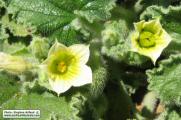 |
 |
 |
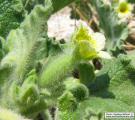 |
IMAGE: ECBEL-01 The plant have different male and female trumpet shaped flowers. This photos shows both of them, the male being at the right side. |
IMAGE: ECBEL-02 Photo of two flowers in situ. Both flowers are male, distinguished from the females by their yellow center of swollen and coiled anthers. |
IMAGE: ECBEL-03 Side view photo of a male flower accompanied by a cluster of another 4 or 5 male flowers still in buds. |
IMAGE: ECBEL-04 Side view photo of a female flower, solitary and with its characteristic inferior swollen ovary. |
 |
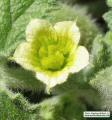 |
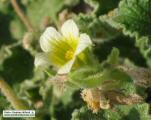 |
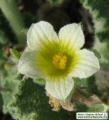 |
IMAGE: ECBEL-05 Close up photo of female flower. It has a green center composed of 3 swollen stigma. |
IMAGE: ECBEL-06 Close up photo of female flower. |
IMAGE: ECBEL-07 Close up photo of male flower. Shape, size and petal colours of male and female flowers are more or less similar. |
IMAGE: ECBEL-08 Close up photo of male flower. |
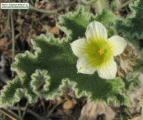 |
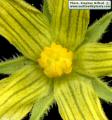 |
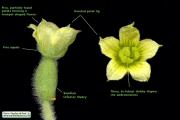 |
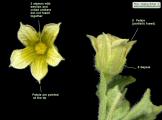 |
IMAGE: ECBEL-09 Photo of a male flower with shrunk or undeveloped stamens. It could be that they were eaten by herbivore insects during development of the flower. |
IMAGE: ECBEL-10 MacroClose up photo of center of a male flower to show in detail the androecium. It looks to be a singular unit but actually they are 3 stamens closely packed together. Also note the 5 hairy sepals and the deep venation of the petals. |
IMAGE: ECBEL-11 Scanned and enlarged annotated image of female flowers (lateral and top view). |
IMAGE: ECBEL-12 Scanned and enlarged annotated image of male flowers (lateral and top view). |
 |
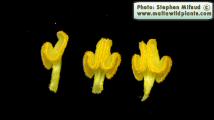 |
 |
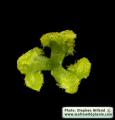 |
IMAGE: ECBEL-13 Lateral view scanned image of male flowers. Another difference between male and female flowers is that male flowers are usually found in clusters of 5 - 6. Females are solitary and terminal. |
IMAGE: ECBEL-14 Scanned and enlarged image of the 3 stamens dissected out from a single flower. They have a coiled (rounded W-shaped) swollen anthers. A strange thing is that one of the stamens is always smaller from the other two. In situ they are closely packed together. |
IMAGE: ECBEL-15 Scanned image of flower with petals folded to show the 3 swollen stigma on a common short style. |
IMAGE: ECBEL-16 Scanned image of the 3 stigma, clearly shows that each is divided into two stubby lobes. |
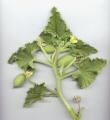 |
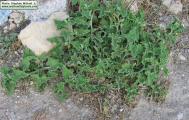 |
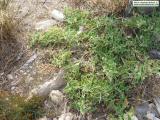 |
 |
IMAGE: ECBEL-17 Scanned image of the plant. Note that all the plant (except flower) is covered by a whitish coat of stiff, not spiny bristles. |
IMAGE: ECBEL-18 Photo of the spreading plant lying on the ground in a waste-ground habitat. |
IMAGE: ECBEL-19 Photo of the spreading plant lying on the ground at the stony edge of a field. |
IMAGE: ECBEL-20 Photo of a leaf that clearly shows that from its axil (zone where leaf is attached to main stem) are growing the cluster of male flowers and fruit (previously a female flower). |
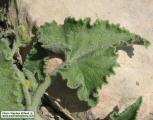 |
 |
 |
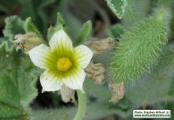 |
IMAGE: ECBEL-21 Photo of a stalked leaf in situ. Triangular in shape with two lobes (rounded or sometimes pointed) at the base. |
IMAGE: ECBEL-22 Scanned image of underside of leaf. More hairy from above, hence its whither colour. |
IMAGE: ECBEL-23 Scanned image of upper side of leaf. Note its undulated (wavy) margin which also contains irregular small lobes or teeth. |
IMAGE: ECBEL-24 Photo of flower and fruit in situ. |
 |
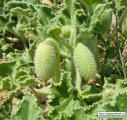 |
 |
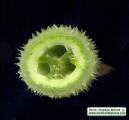 |
IMAGE: ECBEL-25 Photo of the oblong cylindrical hairy fruit that grows up to 5cm in length. |
IMAGE: ECBEL-26 Photo of two fruits of the plant. When ripe these literally explode its juicy content full with seeds. The explosion is stimulated upon touching the stalk just above the fruit. However fruit which is not fully mature would not explode on touching. |
IMAGE: ECBEL-27 Scanned image of 2 fruit. They are always found hanging upside down. The supporting stalk will grow as long as 10cm and more. |
IMAGE: ECBEL-28 Cross sectional scanned image of fruit after its contents have been emptied. It clearly shows that its lumen (cavity) is divided into 3 compartments. |
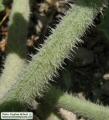 |
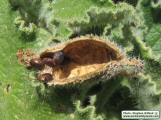 |
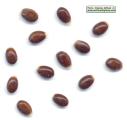 |
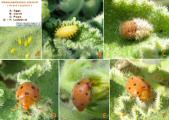 |
IMAGE: ECBEL-29 Close up photo of stem showing the numerous white bristles each having a basal glandular structure. |
IMAGE: ECBEL-30 A dried fruit with some brown seeds glued to it. When the juicy sap of the fruit dries off, it becomes very sticky. |
IMAGE: ECBEL-31 Scanned image of brown, oval, slightly flattened seeds, about 4mm in length. |
IMAGE: ECBEL-32 Composite photo of a common parasite of the plant, the gourd ladybird (Henosipalachna elaterii) during several stages of its life cycle, as explained on the illustration itself. |
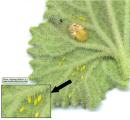 |
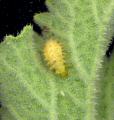 |
 |
 |
IMAGE: ECBEL-33 Scanned image of underside of a leaf having some yellow eggs and a shedding pupa of the gourd ladybird. |
IMAGE: ECBEL-34 Scanned image of the yellow larva with many spiked projections. |
IMAGE: ECBEL-35 Photo of the beetle (ladybird) on a leaf. |
IMAGE: ECBEL-36 |
 |
| | | IMAGE: ECBEL-37 |
IMAGE: ECBEL-38 |
IMAGE: ECBEL-39 |
IMAGE: ECBEL-40 |
|
| | |

